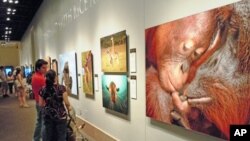The Smithsonian’s National Museum of Natural History is home to a collection of more than 124 million objects, including ancient dinosaur bones and the celebrated Hope Diamond, which many regard as the world's most famous jewel.
But tucked away on the second floor of the iconic institution is another gem of an exhibit which has attracted an impressive number of visitors.
There, colorful, large-format prints showcase captivating images of nature taken by both professional and amateur photographers from all over the world.
These are some of the winning entries in the 2010 Nature’s Best Photography Windland Smith Rice International Awards competition.
The contest drew more than 20,000 entries from photographers in 56 countries. Thirty-nine of the winning entries are now on display at the Smithsonian.
It is a stunning collection of photographs, presenting images of everything from exotic wildlife to a wide variety of plant life and vibrant landscapes.
Nature’s best photography
The annual contest was launched by Stephen Freligh and his wife and co-publisher, Deborah, both lifelong nature enthusiasts. They created the competition in the magazine, Nature’s Best Photography, in 1996.
Each year, the winning entries are featured in the magazine and exhibited online. Since 1998, a selection of the winning entries has also been exhibited at the Smithsonian’s National Museum of Natural History.
Freligh says he created the contest “to celebrate the beauty and diversity of nature through the art of photography.”
Ordinary people, extraordinary images
Freligh looks at every photograph entered into the competition. He, along with a panel of judges made up of photographers, publishers and conservationists, carefully select images for their excellence in composition, use of light, technical accuracy and overall image appeal.
“What we are looking for,” he says, “is something that catches you off guard, that makes you stop and view that image for a longer period of time.”
One of Freligh’s favorite entries is a photograph of an osprey crashing into the water trying to capture a trout.
Grand prize winner: 'Osprey' taken in Finland by Peter Cairns
According to Freligh, photographer Peter Cairns spent endless hours watching the osprey, trying to get the perfect shot. His patience paid off. The photograph was the competition's grand prize winner.
“The whole story was there in that one shot,” says Freligh. “And that’s what makes an image that we feel deserves the position of grand prize.”
Freligh believes every photograph in the exhibit has a story to tell.
“It really has to be a capsule of information that people can get, understand and take away with them,” he says.
Appreciative audience
There did seem to be some take-away moments for several recent visitors who packed the exhibit.
Norman Baade of St. Joseph, Missouri says he has been to Africa several times and was impressed by a photo of two young cheetahs chasing a springbok fawn. It reminds him, he says, of the fragility of nature.
Cheetahs close in on a fawn at Kgalagadi Transfrontier Park in South Africa (Bridgena Barnard)
For Baade, the photo also serves as a reminder that people need to have an understanding and appreciation of other places and the animals that live there.
“If people in general don’t have an appreciation of them, they won’t survive,” he says.
The exhibit inspires twins Claire and Jack Winters, 10, of Austin, Texas, to get closer to nature.
“I think it’s really cool how they captured almost everything in nature," says Claire. "They look so real.”
Her brother is mesmerized by a photo of two orangutans.
“The close-ups really bring out the details in the animal," he says "It looks like it could bite me.”
From the wild, to the walls of the Smithsonian
The contest is named after the late Windland Smith Rice, an accomplished nature photographer and conservation activist who was a 1999 award recipient and passionate supporter of the awards program.
Freligh says his goal for the competition is to recognize talented photographers like Smith Rice and use their work to motivate people to “experience the wild" and, take advantage of modern technology to "go out and get good images.”
His ultimate hope is that all nature enthusiasts will become ardent protectors and guardians of the planet.
The contest begins accepting entries for next year's competition from photographers of all ages and levels of experience beginning Jan.1, 2012.










